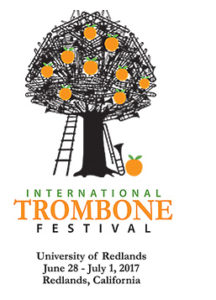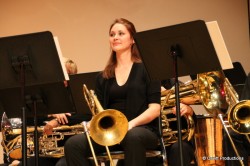Isabelle Lavoie is all set to be a featured artist at the 2017 International Trombone Festival next week at University of Redlands. Isabelle emerged as a young musician in Montreal, made her career in Toronto and has recently soared into the international spotlight as a member of the famed Monarch Brass. A frequent contributor to various international festivals, Lavoie brings her poise, multi-linguality, and insights down from Thunder Bay to “Seven Positions” tm ….Enjoy!
1) Do you hear different characteristics in French as opposed to English Speaking brass players?
Although I have never done any research on the subject, I believe that the differences between the French and English languages do affect articulation, tongue placement and sound in brass playing.
French and English have almost identical alphabets and yet, they sound completely different. French has way more phonetic sounds than what would be expected from the alphabet.The tongue positions are exaggerated and the vowels sound more short and crisp. The vowels can also be oral or nasal (en, un, on, etc), depending on the jaw position and the tongue position in the mouth. French also has sounds that don’t exist in English, such as ‘R’ (throat), and
‘U’ (tongue at the front of the mouth). Many sounds are more rounded in English, which doesn’t occur in French.
 International French and Quebecois French also differ quite a bit. Quebecois French adds an ’S’ sound after the consonants ’T’ and ‘D’. Those sounds ‘T’s and ‘D’s are almost nonexistent in the English language. The tongue position for the vowels is also more extreme, in front of the mouth. The vowels sound darker, longer, as the oral cavity is more open. Quebecois people can also generally speak International French easily, which opens a whole new world of colours and tones. I would assume that the more languages you speak, the more freedom and options you have on a brass instrument.
International French and Quebecois French also differ quite a bit. Quebecois French adds an ’S’ sound after the consonants ’T’ and ‘D’. Those sounds ‘T’s and ‘D’s are almost nonexistent in the English language. The tongue position for the vowels is also more extreme, in front of the mouth. The vowels sound darker, longer, as the oral cavity is more open. Quebecois people can also generally speak International French easily, which opens a whole new world of colours and tones. I would assume that the more languages you speak, the more freedom and options you have on a brass instrument.
I also believe that every note on brass instruments has its own ideal consonant/vowel option for optimal resonance and best sound, but this is a whole other topic!
2) What are your favorite aspects of playing Operatic music? Ballet music?
Opera to me is the ultimate form of Art.
It involves a visual aspect, story telling, acting, vocal and instrumental music-making. When I’m in the pit, I feel like I am part of something much bigger than me and my own little part. I also think of trombone as the most vocal wind instrument which probably explains why I am naturally drawn to the singing voice (especially mezzo soprano & baritone). I always learn something watching and listening to singers: how do they phrase things? How do they breathe? How do they change the colour in their voice to convey different emotions and characters? How do they project the way they do?
Ballet music often has glorious moments for low brass.
What’s not to love?
3) What do you look for in a trombone?
To be honest, I have never been a gear-head. When I find a set up that is low maintenance, that allows flexibility and variety in colour, I stick with it. I want to be able to have both a luscious velvety sound in the mid-low register and a compact sound with just enough brightness. The unsoldered HW Yellow brass bell from Shires I use gives me both of those options. The only thing that my current set up is lacking is more brightness in the mid-upper register. I need to be able to sound more like a ‘Trombone 3’ too.
Any ideas?
4) What is your secret to legato?
It may not be mainstream, but I often use double tonguing: ’DA-DOO-DU-DE-DI’ and ‘GA-GOO- GU-GE-GI’ depending on the register. I also use a whole lot of valve combinations for the smoothest natural slurs and legato articulation (ie. Schumann’s Rhenish or Schubert’s Unfinished solo at the very end on the F).
5) How important has chamber music been to your development? What other experiences have you had, and how did they help lead you to Monarch Brass?
During my Undergraduate Degree back in Montreal, I played with the school symphony orchestra, the new music ensemble, various chamber groups, two big bands, and a fantastic early music group outside of school. Doing it all helped me grow quite fast as a musician. It taught me versatility, awareness and musicianship early on. I started working with professional symphony orchestras at 21. Since I moved to Toronto, I have almost exclusively been working with symphony orchestras and occasionally with brass ensembles.
 I approach playing in large ensembles just like I do in chamber music settings. It really is all about making music as a whole. Most of the time, the low brass section plays in harmony, but often in the classical and romantic repertoire, the bass trombone plays the bass line with the tuba, lower strings, 2nd bassoon, low horns, timpani, etc. Over the years, I have learned to be more and more sensitive to my colleagues: how they sound, how they breathe, how they move. I have learned to adapt and to change my sound/intonation quickly, while providing a solid base to the ensemble.
I approach playing in large ensembles just like I do in chamber music settings. It really is all about making music as a whole. Most of the time, the low brass section plays in harmony, but often in the classical and romantic repertoire, the bass trombone plays the bass line with the tuba, lower strings, 2nd bassoon, low horns, timpani, etc. Over the years, I have learned to be more and more sensitive to my colleagues: how they sound, how they breathe, how they move. I have learned to adapt and to change my sound/intonation quickly, while providing a solid base to the ensemble.
The first time I played with the Monarch Brass Ensemble was at the International Women’s Brass Conference in Kalamazoo, MI, in 2012. I was subbing in for Julia McIntyre, who is a founding member of the group and Principal Bass Trombonist of the Winnipeg Symphony Orchestra. She was and still is the only female bass trombonist to hold a position in a major symphony orchestra here in Canada. Julia and I had only met a couple of times, but there were very few working female bass trombonists in the country then. I am so grateful that she trusted me, because I have been playing with Monarch ever since.
Not only has every performance with the group been some the most musically rewarding experiences of my career, it gave me the opportunity to meet, play and befriend some truly amazing women and musicians. As a member of the group, I have performed at three editions of the International Women’s Brass Conference (2012, 2014 & 2017), at the International Trumpet Guild Conference (2015), at the Midwest Clinic (2016) and at the International Trombone Festival (2016). After performing at ITF in NYC, I was offered to join the Cramer Choir, as well as to perform as a soloist at ITF 2017.
MONARCH BRASS, PLEASE BEGIN AT 19:40
6) How would you compare the different approaches to making music on brass instruments you have observed in England, The US, Quebec, and Toronto?
I have played in sections with people from all over the world, who used different equipment, and who spoke a different language than me. Of course, the differences are always obvious at first, but with musicianship and adaptability, it doesn’t usually take very long to figure things out.
Maybe I think this way because I am from Montreal, which is a melting pot of different schools of brass playing. It is a small artistic centre where the French Canadian brass tradition (Conservatoire de Musique, Université de Montréal, Orchestre Métropolitain, etc.) coexist with the Montreal Symphony Orchestra/McGill University tradition. The MSO has members from all over the globe and includes almost as many Americans as Canadians (English and French) in its brass section. In Quebec, there is room to be yourself as a trombonist as long as your sound and style are engaging and versatile.
Toronto has it’s own style of trombone playing. Almost everyone plays Shires trombones with Greg Black mouthpieces. We tend to play everything very long with a clear front and with a resonant vibrant sound. We like to change our sound and articulations depending on the repertoire we are playing.
In the States, I have mostly played with the Monarch Brass. With the band, we focus on matching each other’s sound and playing beautiful music. Although we all come from very different backgrounds, no one ever sticks out because our priority is the blend. I’ve never had to question myself on how to do things with Monarch Brass.
I also attended the same summer program in England twice, with trombone players from Ireland, the US, Spain, Australia, and a couple of English tuba players. Two of the best sections I have ever played in!
 7) How do you conceive of an ideal bass trombone sound, ad what drew you to the instrument?
7) How do you conceive of an ideal bass trombone sound, ad what drew you to the instrument?
My ideal sound is rich, fat and yet with a lot of core. It has loads of overtones and it has a wide range of colours depending on the register, dynamic, style and character.
Some of my favourite bass trombone sounds: James Markey, Stefan Shulz, Randy Hawes and of course, George Roberts.
Originally what drew me to bass trombone was jazz and commercial music. The first time I heard bass trombone so clearly was in a big band show. I was 14 or 15 years old and I was smitten.
8) Who are your inspirations? Musical & Nonmusical
Being from Montreal, two of my biggest musical inspirations are Alain Trudel and Pierre Beaudry. Not only are they wonderful musicians, they are great teachers, hard workers and human beings you just want to be around
.
My ultimate inspiration is all my colleagues of the Monarch Brass Ensemble and IWBC pioneers, such as Abbie Conant. Women in brass have come a long way, but they still have a long way to go to equality.
c. 2017 David William Brubeck All Rights Reserved www.davidbrubeck.com
Images courtesy of the ITF, ITA and IWBC.
Interested in more “Seven Positions†tm Interviews?
Charlie VernonJames MarkeyChris BrubeckDoug YeoJeremy MorrowTom EverettGerry Pagano Ben van DijkRandall HawesDenson Paul PollardThomas MattaFred Sturm Bill ReichenbachMassimo Pirone Erik Van Lier Jennifer WhartonMatyas VeerStefan Schulz

